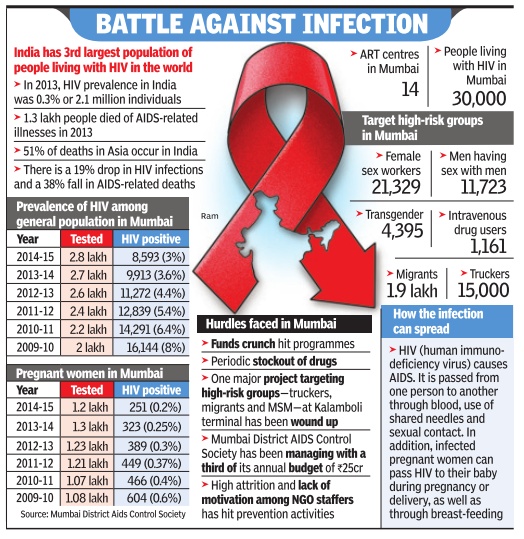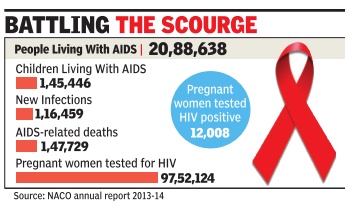AIDS/ HIV: India
This is a collection of articles archived for the excellence of their content. |
Contents |
AIDS in India, 1989-2015: An overview

Malathy Iyer & Sumitra Deb Roy TNN
HIV cases dip, high-risk groups still a worry
When AIDS Day is observed across the globe on December 1, India will enter the third, and perhaps the most perplexing decade of its HIVAIDS epidemic. The first 29 years of AIDS in India (1986-2015) were marked with victory as the human immunodeficiency virus (HIV) metamorphosed from being the deadliest word in public health to just another chronic disease such as diabetes or hypertension.But experts warn that complacency , accompanied by a sharp drop in funding, could prove to be costly for India.
Consider Mumbai for instance. HIV among the city's general population fell from 3.6% in 2013-14 to 3% in 201415.But the Mumbai District AIDS Control Society (MDACS) that manages health programmes for HIV+ people has been managing with a third of its annual budget of Rs 25 crore.“Medicines have had a marvellous effect on the epidemic so far. But we could head for big trouble if patients don't adhere to drugs or fail to get it in time,“ said Dr George Oomen. The country has faced a stockout of HIV drugs in the past few years.
Indeed, while year-onyear, incidence of new infection among the general population and pregnant women has shown a significant decline, that among risk groups continues to be a cause for concern. As per the HIV sentinel surveillance data of 2010-11, HIV among female sex workers in the city was around 6%, way higher than the national prevalence of 2.7%.
However, the main sentiment on the eve of World AIDS Day is of positivity .“What is the difference between HIV in 1985 and 2015? HIV+ people don't really frighten others anymore,“ said Ashok Row Kavi of Humsafar Trust, one of the first organisations started in the country to advocate for rights of men who have sex with men (MSM). “People are living a prolonged life with antiretroviral therapy (ART),“ he said. Dr Shrikala Acharya, additional project director, MDACS, said, “We have come from a stage when HIV prevalence in Kamathipura was 54.3% in 2003. Today , the awareness is massive and everyone knows about ways of prevention.“
Mumbai currently has over 30,000 people living with the disease. A senior NGO member said the disease is no longer a death sentence.But a doctor said the Indian program faces problems that government officials aren't ready to accept.
“Less than a tenth of those who need second -line HIV drugs access them under the government programme.These patients will not only develop further resistance but even spread the disease in the community ,“ hes aid. He added the happy picture could crumble in a few years at the rate it's progressing. “The Centre has washed it hands of funding HIV AIDS programmes and states haven't realised their importance.“
Anti-AIDS gel
From the archives of The Times of India: 2008
Anti-AIDS gel may help men too
A gel designed to protect women from the AIDS virus made using Gilead Sciences’ drug Viread could protect men from infection during anal sex, British researchers reported. Tests on monkeys showed that a gel made using the drug, known generically as tenofovir, may prevent AIDS transmission when applied rectally. The macaques pre-treated with rectal tenofovir gel up to two hours before being given a monkey version of HIV were partly or totally protected from infection, also rectally, Dr Martin Cranage of St George’s University of London and colleagues reported.
2013: Undivided Andhra Pradesh: most pregnant HIV women

Andhra Pradesh has highest No. of pregnant HIV women
Rohit Pillandi,TNN | Aug 19, 2014 The Times of India
HYDERABAD: Undivided Andhra Pradesh reported the highest number of pregnant mothers testing positive for HIV in 2013.
According to recent data from the Union ministry of health and family welfare, 1,330 pregnant women of the nearly seven lakh carrying mothers screened in AP last year, tested HIV positive. The ministry data shows that in neighbouring states like Maharashtra and Karnataka, where a larger number of women were screened, the percentage of women testing positive was significantly lower. It has been estimated that a mother has 30 per cent chance of transmitting the virus to her baby during pregnancy. The mortality rate among children with HIV is much higher compared to adults owing to their under-developed immune systems.
However AP fared better or equally well in treating mothers to prevent transmission to children, as evinced by the data which shows that 1,142 HIV positive pregnant women were put on treatment.
To reduce the numbers of baby transmissions, AP government in a first launched a new regimen of medication and treatment modality in 2012. The new treatment modality requires mothers to start treatment 14 weeks into pregnancy as against earlier practice of taking medication at the time of delivery. The medication now comprises a combination of three drugs as against one compound that was given earlier. Babies now are also given the same medication after birth. Additionally, under the new treatment practice, babies are screened every six months after birth until 18 months of age, when a concluding diagnosis is made about their infection.
According to P L Jayachandra Reddy, additional project director of AP State Aids Control Society, more than 90 per cent of the first batch of pregnant women in undivided AP, who were put on the new treatment modality in 2012, delivered babies without infecting them.
"The transmission rate has come down to about five per cent. It has not been eliminated completely owing to drug resistance some of the women developed during treatment or due to delay in starting the treatment," Reddy said.
A team comprising members of World Health Organisation (WHO) and National Aids Control Organisation (NACO) established this during a study of AP's implementation of the new treatment modality in March this year, 18 months after the first batch of women mentioned by Reddy, gave birth. Buoyed by AP's success, the WHO-NACO team has recommended that the new treatment modality be taken up in other states.
The data was released by Union ministry of health
1,330 pregnant women of the nearly seven lakh carrying mothers screened in undivided Andhra Pradesh last year, tested HIV positive, which is much higher than in other states
2014
4 states in south make up 50% of HIV cases Adarsh Jain The Times of India Dec 01 2014 Coimbatore:
Andhra Pradesh, Telangana, Karnataka and Tamil Nadu account for 3.6 lakh HIV patients -around 50% of the country's 7.7 lakh cases reported as of May 2014. Around 1.7 lakh patients hail from Andhra and Telangana alone.
Karnataka has a little over one lakh HIV patients, and Tamil Nadu, 80,685.
Maharashtra follows Andhra Pradesh, with 1.43 lakh patients. Andhra, Te langana, Maharashtra and Karnataka are the only states with HIV-infected population exceeding 1 lakh, according to the Union health ministry .
Health experts said the rising numbers in the south were due to increasingly efficient screening over the past few years. Besides, while cumulative numbers are high, the number of fresh cases reported every year has plunged since 2010. According to the health ministry , the number of new HIV cases reduced by almost 50% across the country in three years -from 3.1 lakh fresh cases in 2010-11 to 1.5 lakh cases in 2013-14.
Andhra Pradesh, Maharashtra, Tamil Nadu and Karnataka saw a sharp fall in the number of fresh cases reported every year.
The drop in fresh cases is due to increasing awareness among the public, especially the risk-prone communities of sex workers, homosexuals and transgenders, said Bakthavatchalam A, deputy director of Association for Rural Mass India.
After Tamil Nadu's 80,000-odd cases, Gujarat is listed with 40,121 cases.States such as UP, Rajasthan and MP, which are larger in area and population, have not recorded many cases, according to data from the Union health ministry .